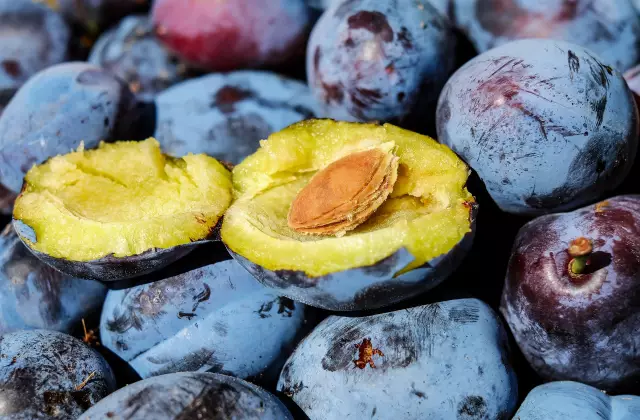- Author Rachel Wainwright [email protected].
- Public 2023-12-15 07:39.
- Last modified 2025-11-02 20:14.
Calorie content of plums
The calorie content of plums is small, so these fruits can be used as part of a non-strict dietary menu for weight loss. Plums have high beneficial properties, and also have a positive effect on the functioning of the digestive, genitourinary and cardiovascular systems.
Calorie content of plums and their beneficial properties

As part of the diet, the effectiveness for losing weight and cleansing the body depends on how many calories are in the plums. Plums are rich in vitamin P, strengthen the walls of blood vessels, normalize blood pressure and help eliminate toxins from the body.
Fresh and dried plums, as well as natural juices from them, are a laxative that is recommended for atony, digestive disorders and constipation, as well as for cleansing the body of toxins. Regular consumption of plums, which have a minimal amount of calories, helps to reduce blood cholesterol and helps to eliminate excess table salt.
Plums as part of a therapeutic diet are prescribed for rheumatism, metabolic disorders, gout and arthritis. Leaves and dried fruits can be used as decoctions and compresses to heal wounds, relieve swelling and redness on the skin.
The average calorie content of plums is 40 units. kcal, as well as 100 g of fruit contains 215 mg of potassium, which has important properties for the human body. Potassium improves heart function, restores nerve impulses and maintains acid-base balance. This substance is necessary for the restoration of the body after diseases of the digestive tract, liver, kidneys, pancreas and disorders of gastric acid secretion.
In plums, calories do not affect weight gain and do not accumulate in the body, but help to maintain performance during a diet and avoid depletion of the body.
The fruits are well digested, have a diuretic, anti-inflammatory, restorative, tonic and healing effect.
Plums can be eaten fresh or dried, boiled in compotes, used to make preserves and jams. The beneficial properties of natural fruits persist for a long time and allow the prevention of various diseases.
Since the calorie content of plums is low, they can be consumed fresh daily for breakfast, as well as snacking on fruits between main meals. Plums can be added to cereals, cereals and yogurt.
Caloric content of plums of various varieties
There are many types of plums, which are divided into European types, thorny plums, mirabelles, renklods and hungarian. Each variety has a distinctive appearance and taste, and the calorie content of plums depends on their type.

Plums of European varieties and blackthorns contain about 45 kcal, as well as 0.8 g of proteins, 0.2 g of fat and 9 g of carbohydrates.
Before choosing a fruit for a diet menu, you need to determine how many calories are in the plum, and then calculate the daily intake.
Given the low calorie content of plums, they can be added to diet salads, stews, casseroles and desserts. It is better not to add prunes to a strict dietary diet, as it contains more than 55 kcal.
Fresh fruits are high in fiber, vitamins and trace elements. European plums and mirabelles have an antioxidant effect and strengthen the body's defenses. These varieties are well suited for liqueurs, compotes, sweet and sour sauces, dressings and canning.
For the dietary menu, you can use Canadian and Chinese plums, cherry plums, American and Ussuri fruits.
Found a mistake in the text? Select it and press Ctrl + Enter.






